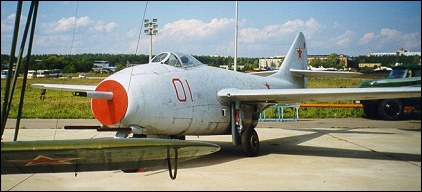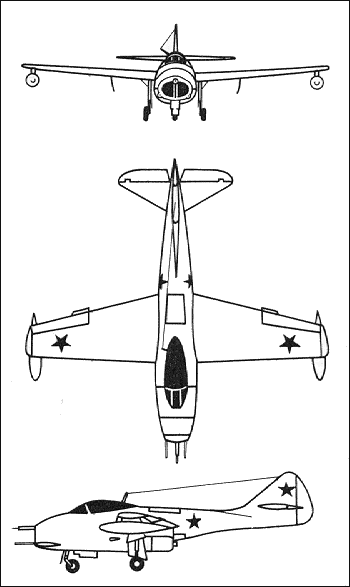 |
Mikoyan/Gurevich MiG-91946 |  |
| FIGHTER | Virtual Aircraft Museum / USSR / Russia / Mikoyan/Gurevich |
 |
Assigned the Izdeliye designation F by the OKB and the initial military designation I-300, the first Soviet turbojet- powered fighter of indigenous design was singularly noteworthy for the brevity of its development programme -14 months between inception and test. The primary design responsibility of Aleksei T Karyev, the I-300 was powered by paired 800kg BMW 003A turbojets, and the first prototype performed a 4m "hop" on 19 April 1946, and its first true test flight on the following 24 April. It crashed during its 19th flight, after logging 6 hrs 23 min, when a wing root fairing detached and destroyed the horizontal tail. Second and third prototypes were flown on 11 and 9 August 1946 respectively, and on the 20th of that month a directive was issued by the NKAP (People's Commissariat for the Aircraft Industry) that 10 more aircraft be built by hand and completed by 22 October. Considered as pre-series aircraft, these were designated FS by the OKB and I-301 officially. With the decision to manufacture the fighter in series the appellation MiG-9 was also assigned - this being curiously non-sequential and previously tentatively issued to the I-210. The first pre-series aircraft was completed on 13 October 1946 - 54 days after issue of the directive - and flown on 26 October, subsequent production aircraft being externally similar. These were powered by paired RD-20 turbojets - reverse-engineered BMW 003As - and armament consisted of one 37mm and two 23mm cannon.
 Two tandem two-seat prototypes were also built, the first of these, the FT-1 (I-301T), retaining the standard armament and flying for the first time in July 1947. The FT-2, which followed on 25 August 1947, had a redesigned cockpit canopy, air brakes and provision for drop tanks. This aircraft was later fitted with the first Soviet production ejection seats. The I-301 version of the MiG-9 suffered from engine stoppages above 7500m as a result of gun gas ingestion. Among attempts to eradicate this problem was the FP (I-302) which simply displaced the 37mm cannon from intake splitter to upper fuselage portside. Rearranged armament was also featured by the more extensively revised FR (I-308), the 37mm weapon being transferred to the starboard side of an entirely redesigned forward fuselage with the 23mm cannon being relocated to port. The forward fuselage embodied a forward- positioned, pressurised cockpit, air brakes and afterburning derivatives of the RD-20 turbojet developed by Kolesov. These engines, designated RD-21 (initially RD-20F) each developed 1000kg. Flown in July 1947, the FP was the first MiG-9 to attain Mach=0.8 under test, and an altitude of 5000m was reached in 2.7 min. Like the FP, the FR did not progress beyond prototype status, but, similarly powered to the latter, the FF (I-307) was built as a small pre-series. Flown in September 1947, the FF (externally similar to the FS) had improved pilot protection (12mm front and back armour, and a 44mm windscreen). This model attained 950km/h at sea level and reached 5000m in 2.9 min, empty and loaded weights being 3471kg and 5117kg respectively.
Valorius, e-mail, 28.04.2021  Barry BarryThe nene was given to the soviets in a lost bet of billiards by the chief designer of RR. Valorius, e-mail, 28.04.2021  Barry BarryThe nene was given to the soviets in a lost bet of billiards by the chief designer of RR.
|  COMPANY PROFILE | |||||||||||||||||||||||||||||||||||||||||||||||
 |

|



20
reply